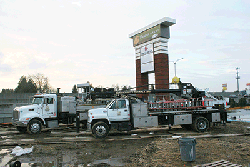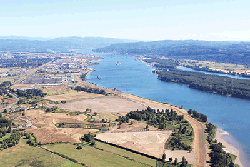Each of southwest Washington’s counties – Clark, Skamania and Cowlitz – have their challenges and opportunities in the coming year. The overall sentiment remains positive, despite budgetary qualms.
It’s going to be a busy year
Marty Snell, Clark County community development director, is optimistic about 2015. He expects “upticks in all sectors of development” – so much so that he said the department’s 2015-2016 budget includes a 3/4-time planner to keep up with the workload.
Simply driving around the county, Snell said, one can see a number of residential developments in progress. If many of those lots are finished by summer, he noted, “we should have a successful year.”
The ongoing fee waiver is spurring commercial development activity. In Hazel Dell, for example, the redevelopment of the Steakburger site is progressing. Snell also mentioned that several industrial sites in the Minnehaha/St. John’s area are pursuing tenant improvements. Larger developments, he said, are “on the horizon” along 78th St., with many already implementing site improvements and early phases of building construction.
The Port of Vancouver is pursuing several projects (see Page 1 article in print edition), such as the Tesoro-Savage Energy Distribution Terminal and the redevelopment of the Terminal 1 property, currently home to the Red Lion Hotel Vancouver at the Quay. Gramor Development’s 32-acre waterfront project expects to begin construction on its first building this spring. In east county, the almost 500-acre Green Mountain residential development project is moving through the applicable regulatory processes.
One challenge with some new projects, said Snell, is infrastructure.
“We’re hearing more about areas that have been brought into the urban growth area in 2007, but have been locked up due to urban holding,” he said.
An example is properties along 179th St., east of the fairgrounds. While Snell admitted that the sewer line from Ridgefield to the Salmon Creek treatment plant will open up “a lot of opportunity,” transportation infrastructure in this area is still lacking.
“The development community wants to have it happen now,” said Snell, “but we need to make sure we have the improvements identified and more-than-ball park estimates for cost, and then decide how we’ll get funding.”
He added that such improvements require partnerships between the private sector and the county.
The port is where it’s at
Robert Waymire, executive director of the Skamania County Economic Development Council, said Skamania County faces two ongoing challenges: 88.3 percent of the county’s land is tax exempt, making it difficult for the county and cities to have a tax base that allows them to keep up with infrastructure. Additionally, he said, the Columbia River Gorge National Scenic Area Act restricts development outside specific urban areas.
Adding to the county’s budgetary woes is Congress’ failure to approve Secure Rural Schools (SRS) funding.
“Our county and schools rely on those funds and now have to slash their already declining budgets,” said Waymire.
Chris Brong, Skamania County commissioner, said that the county had already reduced its 2015 budget by $1.2 million. In late November it became apparent that the SRS funds were not arriving, causing the county to reduce its budget by another $1.5 million – a total reduction of 28 percent. Brong said that Skamania, like many other counties in the western half of the United States, “are not being compensated in hardly any way for the monumental amounts of federal land” in those counties.
 Brong added that the lack of funding or tax base cripples the county’s ability to support residents, businesses and tourists.
Brong added that the lack of funding or tax base cripples the county’s ability to support residents, businesses and tourists.
On the bright side, the Port of Skamania continues to be a hub of activity. John McSherry, port director, said that the port annually receives about $750,000 in lease income and $250,000 in tax revenue from their 240,000 square feet of industrial and commercial properties.
“All of our tenants are growing – and that’s a good thing,” said McSherry.
In fact, the port is struggling to create new space for them to grow into. When Insitu moved out of 75,000 square feet earlier this year, that space was leased the very next day. New tenants include LDB Beverages (a cidery and bottler) and Wind River Biomass LLC.
The port is planning on building a 20,000-square-foot building in 2015 (“the biggest one we can afford”) and has invested about $2 million getting property shovel-ready. For example, they have installed water, roads, fiber optics and power to 32 acres in North Bonneville. Similarly, they have taken over management from the county of the 186-acre former Wind River Nursery. This year they installed broadband access, and a new cell tower will come online in the area in late December. While some of the site’s 19 buildings are not yet in a condition to lease, some of the port’s growing businesses have moved warehousing and manufacturing to the site.
Another aspect of Skamania County’s economic picture is the area’s burgeoning brewery industry. Waymire cited Skunk Brothers Distilling, Walking Man Brewing and Backwoods Brewing (which, he said, is “gaining a lot of traction in Washington and Oregon” and has about 25 employees), along with an unnamed “potential brewery moving into Stevenson soon.”
Waymire has been elected as County Auditor, and said the SCEDC is currently interviewing for a new executive director.
“We are excited about the candidates and believe that they will be able to take the company to the next level,” said Waymire.
Future looking bright
According to County Commissioner Mike Karnofski, Cowlitz County is “in the process of permitting activities for about $2.5 billion in investments in the county.” These projects, he said, are making 2015 and beyond “look much brighter.”
Much of that $2.5 billion rests on the fate of the proposed Northwest Innovation Works methanol plant at the Port of Kalama. Elaine Placido, director of Cowlitz County building and planning, said the project’s scoping phase closed on December 8 and is heading into the environmental impact statement phase. If approved, said Karnofski, the project would generate 2,000 construction jobs and 100 permanent jobs. With a price tag of $1.8 billion, Karnofski said it represented a “significant additional assessment” compared to the county’s total assessed value of $9.1 billion.
The Millennium coal export project is “moving through the permitting process,” said Karnofski. He expects the Department of Ecology to have a draft of the cleanup mitigation plan in the first quarter of 2015. The proposed Haven Energy propane/butane export facility at the Port of Longview represents another $275 million investment in the county.
“All three Ports are getting a lot of interested parties, and the economic development council is busy,” said Karnofski.
Other activities in the county include the Port of Longview’s acquisition of the 300-acre Barlow Point property, which features deep-water access on the Columbia; new light industrial property at the Port of Woodland; a light industrial park at exit 32 in Kalama; and a couple hundred acres east of I-5 recently annexed into the city of Kalama. The latter property will feature youth facilities such as baseball and soccer fields, a city fairgrounds, 200 feet of river frontage and a new park.
On the housing front, Placido said “things are looking up.” Through the end of November, the county had issued 100 single-family homes, compared to 82 last year. Valuation ($21 million) is up about $4 million over last year. Total building permits for the county numbered 922, compared to 811 last year.
Karnofski added that major employers, such as Weyerhaeuser, are currently hiring. But that brings up one of the county’s major challenges – a limited labor pool.
“The pool of skilled trades people isn’t large,” said Karnofski. “Electricians and instrument people,” he said, were especially hard to find.
And the county has its share of budgetary concerns. For example, the Port of Longview has taken over management of Willow Grove Park, and will spend $200,000 upgrading the boat launch there.
“That’s one of the difficulties of county government,” said Karnofski. “We get squeezed, and it’s difficult to maintain our parks.”
But, he said, “I expect things to significantly improve in Cowlitz County in the next two years.”





